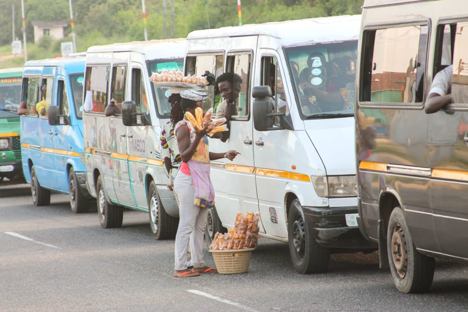New transport fares following the 13 per cent increment took off almost seamlessly last Saturday.
During a visit to a number of lorry stations and transport terminals, the Daily Graphic observed reasonably healthy interactions between transport operators and passengers.
It was also observed that the new fares, as released by the Ghana Road Transport Coordinating Council (GRTCC), had been posted on notice boards to inform passengers.
That helped to avert possible agitation and the heated arguments that arise between passengers and conductors (drivers’ mates) of public transport, also known as trotros, and other forms of public transport.
The Daily Graphic team, made up of Daniel Kenu, Vincent Amenuveve, Justice Agbenorsi, Augustina Dzodzegbe and Felicia Kwarteng, observed that most passengers had resigned themselves to paying the new fares and came prepared with small denominations and even coins just to pay the right fare and avoid being overcharged.
New fares
The new fares, as announced by the council last Tuesday, to take effect from June 5, cover intra-city commercial vehicles, popularly known as trotro, shared taxis and long-distance vehicles.
The council is made up of all transport operators in Ghana, including the unions and associations, other locally based associations and other operators (both passenger and road haulers).
The Ghana Private Road Transport Union (GPRTU), the main body that controls public transport, explained that the increase was to accommodate the increase in fuel prices announced in May 2021, after long negotiations with stakeholders.
According to a new list of fares released by the GPRTU, a distance which usually cost GH¢5 will now cost GH¢5.70, GH¢3 will now cost GH¢3.40.
A long-distance fare of GH¢40 will now cost GH¢45, while a distance which used to cost GH¢100 will now cost GH¢113.
Observation
Although the implementation was generally peaceful, there were pockets of arguments on some vehicles, as some mates tried to charge more than the 13 per cent, which elicited some reactions from passengers.
Also, while some transport operators decided to charge the new fares from last Friday evening, instead of Saturday morning, others, mostly intra-city commercial vehicle drivers, said they would effect the increment from today.
In Bolga, taxi drivers were yet to charge the new fares as of yesterday for fear of losing their passengers, as their business was already struggling to attract patronage.
Accra
Justice Agbenorsi reports that the team observed that some bus conductors had inflated the transport fare above the 13 per cent increment.
For instance, the transport fare from Kpogas on the Giffard road to the 37 commercial bus station was previously GH¢2, and based on the press release from the transport operators, the new fare should be GH¢2.30.
However, some drivers charged GH¢2.50, and that caused some friction between passengers and the conductors, but the passengers ended up paying the GH¢2.50, as the drivers refused to continue the journey if they did not pay.
Other drivers also printed the press release and posted it in their vehicles for passengers to refer to the new fare increment to avoid any misunderstanding and argument.
Not enough prompting
At the Kasoa to Cape Coast Station, Felicia Kwarteng reports that most passengers said they were not aware that the new fares were taking effect from that day, for which reason they were not prepared to pay the new fares.
They said they expected the new fares to take effect from today, June 7, to allow for more information since the announcement.
Madam Abena Dapaah, a parent travelling to visit the son at the Cape Coast school for the deaf and blind, said she was not aware the new fares took off from Saturday, and that she could only afford the old fare of GH¢23.
“I am aware fares have been increased, but I have no idea they take effect from today. I actually thought it was going to start on Monday. Now as it stands, I can only afford the old fare of GH¢23 and not the new one of G¢¢26,” she said.
At the VIP Station, Mr Amos Mensah, a ticket seller, told the Daily Graphic that so far there had been no misunderstanding among passengers, as the new fares were boldly posted at the ticket area for customers to refer to them before buying their tickets.
The GPRTU Chairman at the Tema station at Tudu, Mr Amidu Gyahu, told the Daily Graphic that the association had the interest of its drivers at heart and so it had printed and photocopied the new fares and asked each driver to post a copy in his vehicle, so passengers would not fight over the fares.
Drivers happy, passengers not
From Sekondi-Takoradi, Augustina Dzodzegbe reports that the increment has been received as welcome news by commercial drivers, while it has caused agitation among commuters in the metropolis.
At the Abenbebom bus terminal, the fare for air-conditioned buses from Takoradi to Kumasi is now GH¢57, against the previous fare of GH¢49, while buses without air-condition from Takoradi to Kumasi which charged GH¢44 now take GH¢49, in compliance with the agreed percentage.
A check with Intercity STC from Sekondi-Takoradi to Accra indicated an increment from GH¢42 to Gh¢47 per passenger.
For intra-city commercial vehicles, from Effiakuma to market circle is now GH¢2; from market circle to Apremdo is now GH¢2.30, while from new site to Sekondi is now GH¢2.50.
At the GPRTU office, a “bookman”, Mr Ebenezer Donkor, said currently they had not increased their fares due to the high level of competition around them.
“We have a lot of buses plying Accra lately, with fewer demands, so we are still waiting to hear from our people at the Accra office before implementing the increase,” he said.
Ahead of time
From Kumasi, Daniel Kenu, reports that even before last Saturday, some drivers had subtly increased their fares and so to some commuters it was not new.
The difference ranges between 20Gp and GH¢10, but for some, especially market women, it was such a great deal.
“The difference may look small, but, cumulatively, it’s quite high. The multiplier effect on goods and services will be really felt in the coming days,” Rose Marfo, a social worker who commutes between Abuakwa and Adum daily, told Daily Graphic.
A number of drivers, however, still believe the fares needed to be adjusted again because the cost of everything, including spare parts, have shot up dramatically.
“Fuel prices keep going up each day. By next week, the new increment at the pumps will render this new transport fares ineffective,” Jones Acquah, a commercial driver who plies between Adum and Tech, said.
Taxis stick to old fares
From Bolgatanga, Vincent Amenuveve reports that while some lorry stations have increased fares, others are reluctant to increase the fares for fear of losing passengers.
At the Main Bolgatanga lorry station, for instance, drivers plying the Bolgatanga-Sirigu stretch are still charging the old fares.
They charge GH¢10 for taxis and GH¢8 for trotros.
A driver at the Sirigu lorry station, Mr Anonsoe Akobulgo, said they were charging the old fares because they were afraid of losing passengers.
He explained that there was the need for the government to reduce fuel prices and fix the deplorable roads in the Sirigu area.
He indicated that they were not making profit because of the high fuel prices, bad roads and high cost of spare parts.
A passenger, Mr Ignatius Akolbire, appealed to the government to rather consider reducing fuel prices to ameliorate the suffering of those in the rural communities.
He observed that when fuel prices were reduced, it would impact positively on the living conditions of the ordinary Ghanaian, particularly those in northern Ghana.
Other fares
Meanwhile, at the Bolgatanga-Tamale lorry station, fares have been increased.
Mini vans are now charging GH¢35, while small cars are charging GH¢ 40. The old fares were GH¢30 and GH¢35, respectively.
Buses loading passengers from Bolgatanga to Kumasi at the Bolgatanga main lorry station have also increased fares from GH¢80 to GH¢90.
Internally, the Mahama-can-dos are now charging GH¢2, up from the GH¢1.50 that was being charged.










Discussion about this post